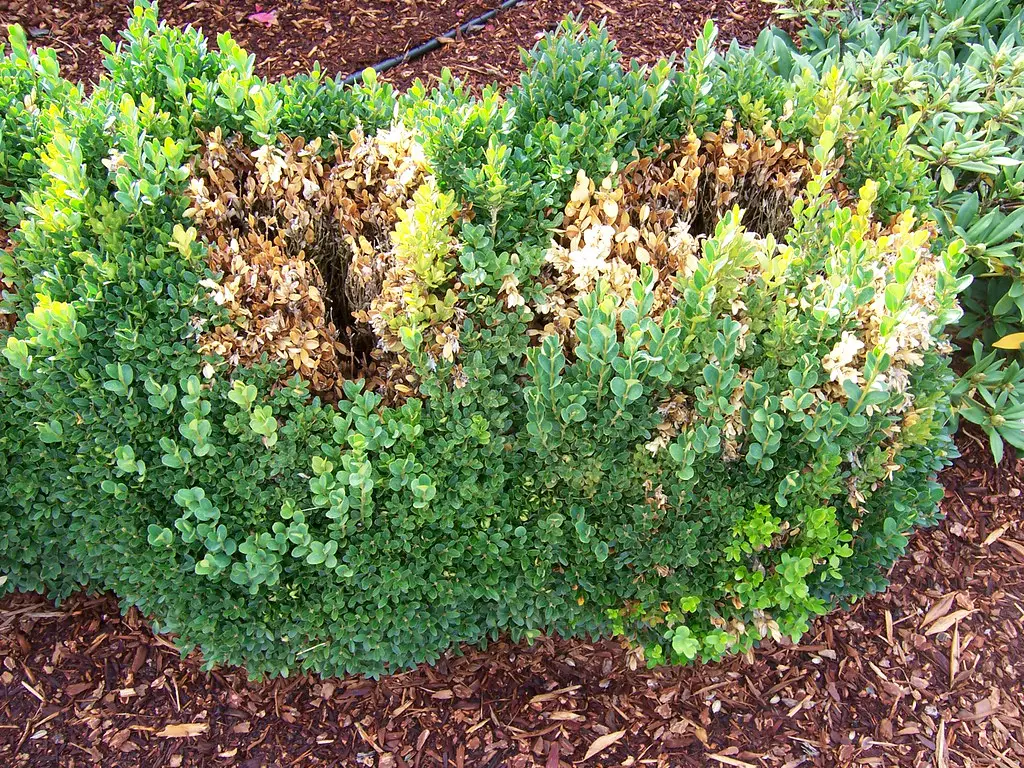Boxwood blight, caused by the fungal pathogens Calonectria pseudonaviculata and Calonectria henricotiae, is a severe and highly contagious disease that threatens boxwood shrubs (Buxus spp.). It has become a major concern for landscapers, nursery growers, and gardeners due to its rapid spread and devastating impact on the popular ornamental shrub. In this in-depth blog post, we’ll explore the symptoms, life cycle, impact, prevention, and control measures of boxwood blight.
Symptoms of Boxwood Blight
The following are common symptoms of boxwood blight:
- Leaf Spots: Dark or light brown circular spots on the leaves.
- Stem Cankers: Black streaks or lesions on the stems.
- Defoliation: Rapid loss of leaves, often starting at the base of the plant and moving upward.
- White Spore Masses: In humid conditions, white spore masses may appear on the undersides of leaves.
Life Cycle of Boxwood Blight
The life cycle of the fungi responsible for boxwood blight is complex and can be summarized as follows:
- Spore Production: The fungi produce spores that are released into the air.
- Infection: Spores land on susceptible boxwood plants, germinate, and infect the plant through natural openings or wounds.
- Spread: The infection spreads rapidly, causing visible symptoms.
- Survival: The fungi can survive in infected plant debris or soil, waiting for favorable conditions to infect new hosts.
Impact of Boxwood Blight
- Aesthetic Damage: Boxwoods are often used for hedging and landscaping; blight can ruin their appearance.
- Economic Loss: The disease can lead to significant losses for nurseries and landscapers.
- Environmental Impact: Chemical control measures may have environmental implications.
Prevention and Control Measures
Prevention
- Purchase Healthy Plants: Inspect new plants for symptoms of boxwood blight and buy from reputable sources.
- Quarantine New Plants: Isolate new boxwoods for several weeks to ensure they are disease-free.
- Avoid Overhead Watering: Watering at the base reduces humidity on the foliage, lessening the chance of infection.
- Proper Spacing: Ensure proper spacing between plants to allow for air circulation.
Control
- Remove Infected Material: Prune and dispose of infected plant material properly.
- Fungicides: Apply fungicides as a preventive measure or at the first sign of disease. Consult local agricultural extensions for recommendations suitable to your region.
- Sanitize Tools: Regularly clean and sanitize tools used on boxwoods to prevent the spread of the pathogen.
- Avoid Planting in Infected Areas: The fungi can survive in the soil, so avoid planting boxwoods in areas previously infected.
Resistant Varieties
Research is ongoing to develop boxwood varieties that are resistant to blight. Consider these varieties if available in your area.
Conclusion
Boxwood blight is a serious and challenging disease that has rapidly spread to affect a wide range of Buxus species. The impact of this disease is not only economic but also affects the beauty and functionality of landscapes and gardens.
Prevention is key in managing boxwood blight, and it requires vigilance, proper cultural practices, and careful selection of plants. When prevention fails, early detection and appropriate control measures can minimize damage.
Cooperation between researchers, nurseries, landscapers, and home gardeners is essential in understanding, preventing, and managing this disease. By staying informed and following best practices, it’s possible to enjoy the elegance of boxwoods without the looming threat of blight.
